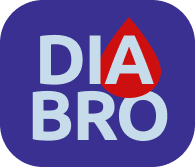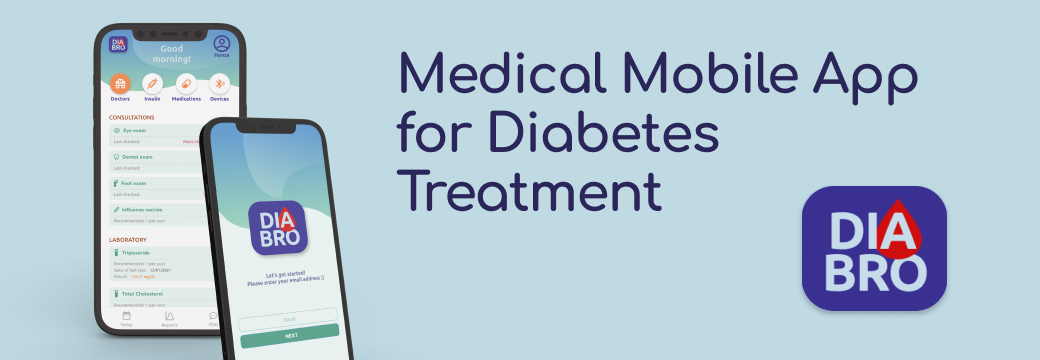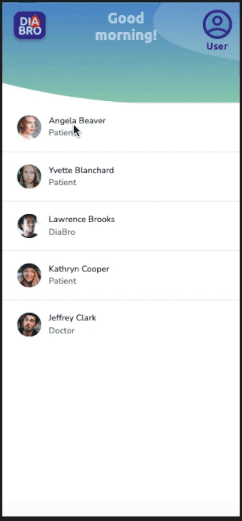
Dia-Bro-App


 0
0 0
0

What's new in this version
Initial Release

Introduction:
We wanted to bring in healthcare a completely new solution to make diabetes diagnostics easier and more complex. We believe that our approach in implementing FHIR and IRIS systems to processing and storing medical data can prevent patients from many further pathologies connected with gestational diabetes. It will simplify patients’ and physicians' daily routines.
UPD: In version 2.0 of DiaBro, we have added ‘Pregnancy journal’ feature, since blood sugar that is not well controlled in a pregnant woman with Type 1 or Type 2 diabetes could lead to problems for the woman and the baby. This feature will allow practitioners to track risk factors in gestational diabetes in real-time to take quick action in case of fatal changes in a patient's condition.
Problem:
- Patients' irregular doctor appointment
- Patients forget to take their medications on time
- Lack of patient everyday data collection (symptoms, BP, weight tracker) for the prevention of pathologies in gestational diabetes
- Practitioners unable to monitor patient glucose spikes in real-time
- Patient doesn’t have an overview of the prescriptions
Solution:
We have connected the data from FHIR and IRIS by using Kotlin and React. Main data (doctors, appointments) goes from FHIR, and additional (due to doctor's request) from IRIS. This helps to keep only precedence information in the FHIR (hospital database) and not overload the system with secondary information (e.g. patient's personal notes about his/her everyday condition). FHIR can be used for data transformation and analytics.
Considering the integrability of IRIS for Health and its formats used in the healthcare industry, in our further development we are planning to store and process all main data from the hospital with additional patient data that couldn't fit in FHIR format.
Our products and services:
- An application for real-time everyday patient condition monitoring (glucose level, BP, insulin intake, symptoms)
- Reminders for the patients of everyday medication intake, their future appointments, and tests.
- Tab with current and past prescriptions
- Visual graphics of glucose level changes for both patients and physicians
- Input for the amount of insulin injection based on glucose level for statistic
Nice to have in the future:
- Bluetooth connection with all the patients’ devices they use for everyday diabetes control
- Connection with a partner applications
Outcome:
DiaBro Multiplatform App can help end-customers such as Patient and Physician to get rid of time-wasting processes they go through in their everyday routine. Introduce to them new modern methods for tracking, collecting, and storing all necessary data in one Application. Because of this App simple usability, accessibility and constantly actualized information, the experience of use will become interactive and even addictive.
During our process of development, our goal was to highlight IRIS for Health integrational capabilities not only with JavaScript or Python but with React Native tech stacks.

Backend part of diabetes and pregnancy symptoms tracking app.
Local installation: To run locally download frontend: git clone https://github.com/elisemax/client.git And backend: git clone https://github.com/Comodo13/Dia-Bro-App.git
Inside client folder:
npm install
npm start
Inside Dia-Bro-app folder:
java -jar deploy.jar
Run IRIS for Health Community edition docker-container:
sudo docker run --name iris -d --publish 1972:1972 --publish 52773:52773 containers.intersystems.com/intersystems/iris-community:2022.1.0.209.0 --check-caps false
For communication with FHIR REST API I implemented my custom mapper, but then I found out amazing connector library hapi-fhir-base, hapi-fhir-client. Last week my FHIR server from Hackaton stopped working so I had to mock data in code for demo reasons.
For communication with IRIS for Health I used intersystems-jdbc connector. There is support of Hibernate (ORM for Java). Because of IRIS for Health internal NoSQL structure, I wanted to test IRIS amazing speed performance with pure SQL. Maven successfully does job of ZPM: adding ingintersystems-jdbc.jar to project library and compiling.
For communication with FrontEnd we use REST. UI layout is generated at backend part for performance optimization reasons. At the same time we expose standart rest api for other consumer applications.
Front-end part:
App was created using React, Redux, Typescript and Tailwind css. This app can be used like ReactComponents library to connect and visualize data from InterSystems database. You can easy create your own application using this react library
Used technology:
The React part is written in Typescript.
The Redux part is written in plain Javascript for the sake of simplicity.
The Tailwindcss is already define css styles.
Our Demonstration video:

Our team:
https://community.intersystems.com/user/dzmitry-rabotkin
https://community.intersystems.com/user/maria-muzychuk
https://github.com/elisemax
Big thanks to Evgeny Shvarov for introducing us to InterSystem infrastructure!
